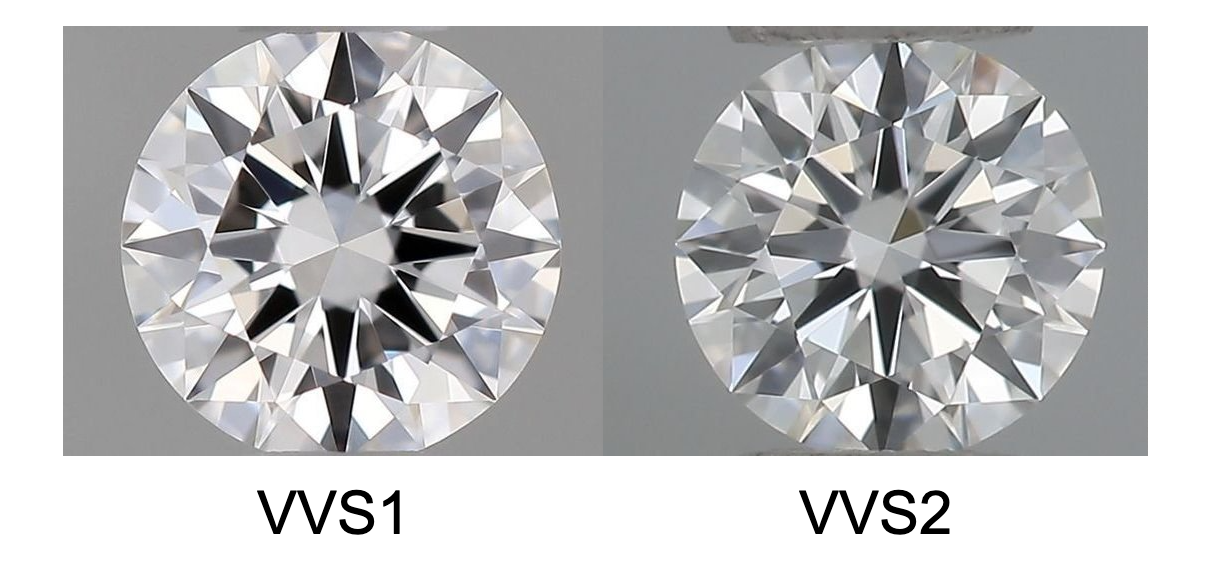VVS Diamonds: The Clarity Grade You Need to Know About

When shopping for a diamond, you may notice that a few confusing classifications come into play. This is especially true with regards to diamond clarity. Clarity is just one of the four Cs– cut, color, clarity, and carat.
VVS or very very slightly included diamonds carry a clarity distinction that affects both the style and price of a diamond. With diamond pricing, a mixture of all of four C’s is taken into account. VVS diamonds are very popular, due to their purity, and as a result of said purity, they’re also known for being a bit more expensive.
What Are VVS Diamonds?

A VVS2 diamond.
VVS diamonds are diamonds that ultimately only retain minimal inclusions. VVS inclusions, although undetectable except through the use of a magnifying lens, are always taken into account when determining a diamond’s purity, and ultimately, its value.
The Difference Between VVS1 and VVS2 Diamonds
The VVS clarity grade includes two subcategories: VVS1 and VVS2. Inclusion location is part of the information that decides whether a diamond is classified VVS1 or VVS2.
If the inclusion is closer to the edge of the diamond, and therefore less detectable, it’s considered a VVS1 stone. If, on the other hand, the inclusion is nested in the heart of the stone, it is classified a VVS2 stone.
How Is Diamond Clarity Measured?
Inclusions are judged and measured in a variety of ways, each of which ultimately decides a diamond’s clarity. Although a multitude of inclusions will generally lower the value of a diamond, even a few inclusions, if they are considerably sized or poorly located, will also do the same.
Typical VVS Inclusions
Size and position of inclusions are also important because they may affect a diamond’s long-term durability, or compromise its translucency. Below, we’ll detail five common diamond imperfections that may, to certain degrees, be found in VVS diamonds:
- Feathers are small cracks or fractures that are not visible to the naked eye when found in VVS diamonds. However, in other situations, they can be quite visible. They can be white, or even multicolored, and usually occur when a diamond is formed, rather than during its cutting.
- Pinpoints are small deposits of minerals. They can be solitary or found in clusters. Sometimes diamonds can serve as pinpoints, thereby making for a diamond within a diamond.
- Clouds are where three or more pinpoints are gathered.
- Internal Graining occurs when uneven, wave-like patterns result from a diamond’s growth.
- Needles are thin, elongated crystals that look like tiny rods when magnified 10x.
Clarity grades are referred to in slightly different ways depending on the diamond grading lab. For example, the American Gem Society (AGS) takes the traditional clarity scale one step further by adding a numerical value to the industry standard verbal descriptors. Here’s a comparison between the GIA clarity scale and the AGS clarity scale.

Should I Buy A VVS Diamond?
For most people, a VVS diamond really does make for the perfect diamond. If it’s a VVS1, it’s only one step below flawless. And as touched upon above, even a VVS2 diamond’s imperfections won’t be able to be spotted by the naked eye. When imperfections are not visible to the naked eye, they are known as ‘eye-clean’ diamonds. All VVS diamonds are ‘eye-clean.’
Although exceptionally beautiful, it’s important to not forget or be deceived by shady jewelers into thinking that VVS diamonds are as good as a diamond gets. Depending on your budget and personal preferences, you may find that a diamond with a different clarity grade still fulfills all your expectations for a beautiful diamond.
Where Can I Find VVS Diamonds?
If your heart is set on a VVS diamond, do consider each of the four Cs previously mentioned. Cut, color, and carat also play huge roles in what a diamond will ultimately mean to you or your loved one.
Also, if you’re looking for a safe place to look at VVS diamonds, where you won’t have to worry about an opportunistic jeweler breathing down your neck, check out our inventory of VVS diamonds.


